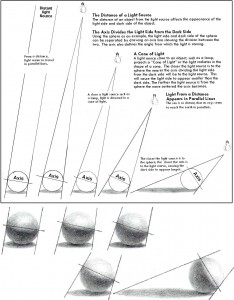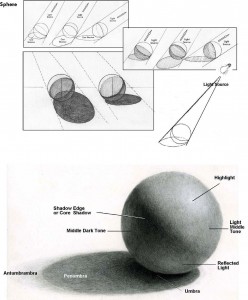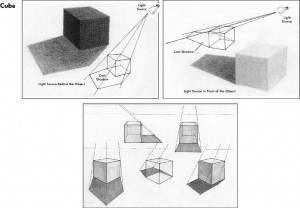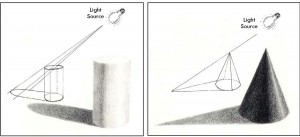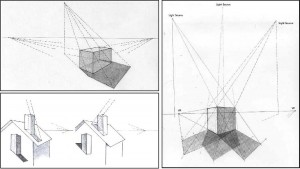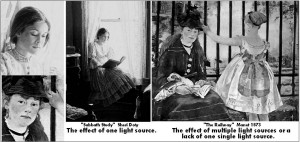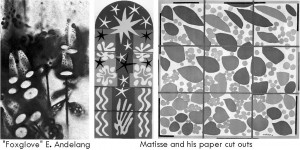A Light Source and Shadows
A light projected onto an object or figure creates lights, darks, and cast shadows. Your source of light may be the sun, the moon, a light through a window or an artificial light. When several light sources are present the light and dark tones vary and are less predictable. To simplify the study of light and shadow in this first section, I will use only one light source.
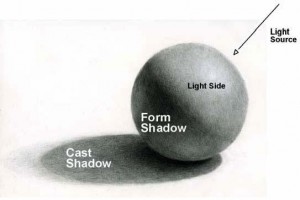
|
Two Kinds of Shadows
There are two kinds of shadows that occur when one light shines on an object, a cast shadow and a form shadow.
Cast Shadow
When an object blocks a light source it casts a shadow. A cast shadow is not a solid shape but varies in tone and value. The farther a cast shadow is from the object which casts it the lighter and softer and less defined becomes its edges.
Form Shadow
A form shadow is the less defined dark side on an object not facing the light source. A form shadow has softer less defined edges than a cast shadow. Form shadows are subtle shadows essential for creating the illusion of volume, mass and depth. The changes in form shadows require careful observation – quinting at the subject to see value definition affected by figure-ground making value relationships clearer.
|
A Light Side and a Dark Side on Round or Circular Surfaces
When one light source is present, I was taught the dark side is “always”darker than the light side of the object and the light side is “always” lighter than the dark side. Establishing a definite light side and dark side makes round objects appear round and defines the form of an object accurately. Use this simple trick
to make your artwork more true to life, separalight tones avoiding figure-ground confusion.
| 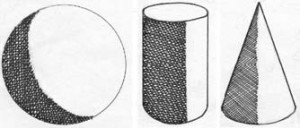
|
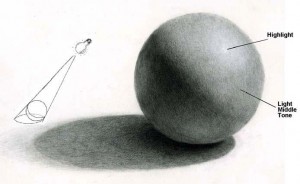
|
THE LIGHT SIDE IN TWO PARTS
Highlight
The lightest spot or streak is where the
light strikes the subject in exactly the
middle of the light side between the
shadow edge and the edge of the
object. A highlight can be shinny and
crisp on a glass or metallic surface, or
fuzzy and muted on a dull or textured
surface.
Light middle tones
Note, to avoid confusion, “always”
keep the values on the light side lighter
than the values on the dark side. In
reverse, the values on the dark side
are darker than the values on the light
side. It’s the middle tones on either
side that confuse the artist’s eye in
value relationships.
|
The Dark Side in Three Parts
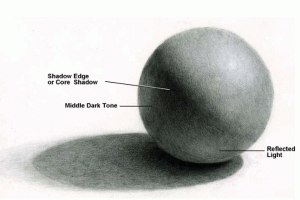
|
Form Shadow in Three Parts
“Shadow edge” or “core shadow”
The edge where the light is blocked from the light
source is the darkest value on the dark side. The core
or darkest value blends into the middle tones from the
shadow edge on round subjects.
Dark middle tone
The variable values blended form the shadow edge on the dark side. Again, the dark middle tones are darker than any values on the light side. The human eye can trick the brain into believing the
lightest values on the dark side are the same as the darkest values on the light side. If the artist is confused about lights and darks, the rendering is less understandable.
|
Reflected light
If the object being painted is sitting on a white table, the light from the table reflects back onto the object and makes the shadow side lighter. If the object of the painting is resting by something black or dark, the middle values will become a dark reflection. The concept also holds true when the object of the painting is sitting on a colored surface. If the reflected light is reobject.
Cast Shadows
When the source of light is blocked by an object it casts a shadow. The length and shape of the cast shadow depends on the placement of the light source. Long shadows are cast from a side light source (as from the sun in late afternoon or early evening), and short cast shadows are cast from over head (as from a noonday sun). The shape a shadow casts depends on the shape of the object casting it and how closource is to the object.
| 
|
CAST SHADOWS IN THREE PARTS
The vocabulary used to describe cast shadows in art come from shadow descriptions in astronomy. The umbra, penumbra and antumbra are the three distinct names given to the description of shadows cast by heavenly bodies. The umbra is the darkest part of a shadow considered the absence of light. The penumbra is a lighter outer shadow where the object is only partially obscuring the light. The antumbra is more obscure. When it is visible it seems to extend out from the penumbra in a lighter and less distinct way.
Light Source, Cast Shadows and the Axis
Cast Shadows The Sphere
The Cube
The Cylinder and Cone
More on Cast Shadows
Too many complex cast shadows can be confusing. Such objects can be rendered by blurring the edges.
Daylight and Cast Shadows
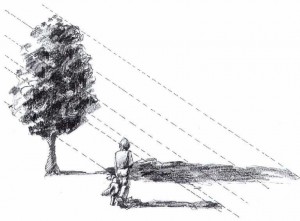 | Cast shadows of irregular shapes and in natural sun light are open for interpretationbecause of the constant changing sunlight: As you work on location, the sun will continue to advance and change what you are drawing. Note the place you would have the sun be positioned, and keep that constant to avoid a confusing spread of shadows. The nature of shadow is affected by weather, sunlight,moonlight, or artificial light. |
Multiple Light Sources or an Undefined Light source
Multiple light sources or an undefined light source minimizes the gradation of values and flattens the sense of volume in three dimensional objects. Because of this lighting affect, artists such as Manet painted colors in flat areas neglecting the use of one light source to create shadows. An undefined light source causes a sense of shallow space. Some art critics believe this sense of shallow space to have paved the way for “nonrepresentational” uses of value and color.
Manet’s Painting, “The Railway” shows value contrast in composition, but the sense of shallow space is emphasized by a lack of a single light source.
Objects Have Light, Medium or Dark Values
Objects have an allover light, medium or dark quality. To make your representation more believable, you should take into consideration the light or dark value of each object. Before you render details, block in the value characteristics of each object. Using this strategy will save you time and hachieve a more realistic result.
| 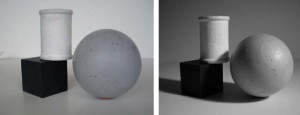
|
Value Schemes and Mood
You create a sense of mood or interest depending on the combination of values present in a work of art. When value contrast is limited to a small range of tonal variations the result is one of understatement and calm. “High Key” is the term used for a light value scheme. All middle tone values are in a “Medium Key” range.
And “Low Key” refers to an allover dark toned value scheme. Sharp value contrast evokes strong emotions in the viewer suggesting drama or conflict. Extreme value contrast in a value scheme refers to a style of chiaroscuro called “Tenebrism”.
| 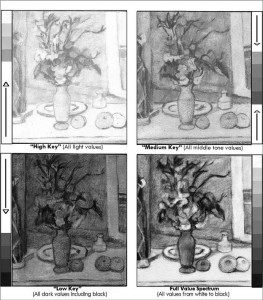
|
Value as Pattern
Controlled shallow space is illustrated by the early cubists such as Picasso and Braques. Their paintings are taken from realistic subject matter and abstracted into unified flat tonal planes. The planes are shaded individually with the semi-illusion of space with no light
source. Later, each plane takes on characteristic value combined with other planes with the same style of value pattern. This produces a carefully conceived two dimensional pattern of light and dark values. The shallow space develops a three dimensional effect through the characteristics of the advancing and receding values.
| 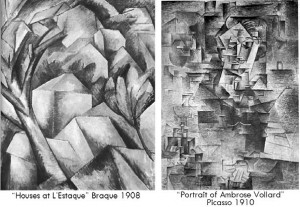
|
Decorative Effects of Light and Dark Contrast
Artists using the decorative effects of light and dark contrast ignore the use of the conventional tools of light logic all together. When light effects appear, it is often based on the total design of the artwork.
Compositional Functions of Value
Today most artists use value as a vital tool in pictorial composition. Value contrast is an intrinsic factor in pictorial organization, in showing dominance in design, creating two dimensional patterns, establishing mood and producing spatial unity. The effectiveness of a work of art or design is in large measure based on the use of value.






